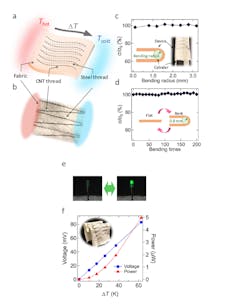Tailored Carbon Nanotubes Yield Energy-Harvesting Textile
What you’ll learn:
- How carbon nanotubes can be fabricated as threads and combined to harvest useful power.
- The enhancements needed to CNTs to make them viable source of thermoelectric energy via the Seebeck effect.
- The results of the project, including fabric output power and efficiency power factor.
There’s no shortage of research effects seeking to use fabric as a viable source for energy harvesting. It makes sense, as fabric-based harvesting appears to offer a fertile potential area for such exploitation. A material used to pursue this goal takes advantage of carbon nanotubes (CNTs), which have already demonstrated many unique and useful properties in this area.
A team based at Rice University, working in conjunction with Tokyo Metropolitan University, developed and transformed CNTs into a thermoelectric (TE) energy source in a fiber-enhanced, flexible-cotton fabric. It employs the well-known Seebeck effect to convert heat into enough energy to power an LED.
Obviously, there are hurdles to using carbon nanotubes. Nonetheless, they appear to be promising candidates due to their one-dimensionality plus unique advantages such as flexibility and light weight. However, preserving the large power factor of individual carbon nanotubes in macroscopic assemblies has been challenging, primarily due to poor sample morphology and a lack of proper Fermi energy tuning.
Fermi energy (EF) is a parameter in quantum mechanics that refers to the energy difference between the highest and lowest occupied single-particle states in a quantum system of non-interacting fermions at absolute zero temperature. This concept is useful above 0 K temperature for describing and comparing the behavior of different semiconductors.
High Giant-Power-Factor Fibers
The team produced fibers and fabric with a high value of giant power factor (PF) resulting from the ultra-high electrical conductivity they achieved through excellent sample morphology, combined with an enhanced Seebeck coefficient via Fermi energy tuning. As noted by Rice graduate student and lead author of the paper Natsumi Komatsu, “The power factor tells you how much power density you can get out of a material upon certain temperature difference and temperature gradient.” (Note: This TE harvesting power factor is completely unrelated to the power factor associated with ac power supplies and reactive loads.)
They maintain that the PF they achieved—14 (± 5) mW/m-K2—is the highest value ever achieved for any CNT sample of macroscopic wearable fibers of aligned carbon nanotubes with ultra-high electrical and thermal conductivity (Fig. 1).
1. Textile thermoelectric (TE) generator based on carbon-nanotube (CNT) threads sewn into fabric: (a) Schematic and (b) photograph of the device. CNT threads (p-type thermoelectric generator) and steel threads (for electrical connection) were sewn into a fabric using a sewing machine. The CNT threads were connected electrically in series and thermally in parallel. A temperature difference ΔT was applied by heating one side (Thot) while keeping the other side (Tcold) at room temperature. (c) Electrical conductivity σ of one TEG unit as a function of bending radius, normalized by the conductivity without bending (σ0). The inset shows a schematic and a picture of the device during the measurement. (d) σ as a function of bending number, normalized by that of the original state (σ0). The bending radius was 0.8 mm. The inset shows a schematic of the measurement procedure. (e) The entire device was connected to an LED through an amplification circuit and a capacitor. The LED turned on with a ΔT of ~50 K. (f) Output voltage and power as a function of applied ΔT. The inset shows a folded device, demonstrating its flexibility.
Thread Sewing Demo
The CNT fibers can be woven or even sewn by using a commercial sewing machine, and they’re washable—attributes that are difficult to achieve using other TE-functional fibers. To demonstrate this, they fabricated a high-performance textile TE generator based on CNT threads sewn into fabric. The thread was produced by plying 21 CNT filaments together, with an average CNT thread diameter of 190 μm. They sewed the CNT threads and stainless-steel threads into a fabric (100% cotton) such that the CNT threads were connected electrically in series and thermally in parallel (Fig. 2).
2. Carbon nanotubes woven into thread-like fibers and sewn into fabrics become a thermoelectric generator that can turn heat from the sun or other sources into energy.
They then generated a temperature difference, ΔT, across the device by heating one side (Thot) with hotplates while keeping the other side (Tcold) at room temperature. The CNT threads generated power through the Seebeck effect, while the steel threads provided electrical connections (Fig. 3).
3. (a) One thermoelectric generator (TEG) unit is equivalent to a voltage source and a resistor. b) The entire circuit to power the LED consists of four TEG units connected in series, a capacitor, a dc-dc converter, an LED, and a switch. The converter operates when the input voltage is 40 mV or higher, and the output voltage is between 1 and 10 V depending on input voltage and load. When the switch is connected to A, the capacitor is charged by the TEGs; when it switches to B, the capacitor discharges and lights up the LED.
In addition, the giant power factor they observed make these fibers strong candidates for the emerging field of thermoelectric active cooling, which requires a large thermoelectric power factor and a large thermal conductivity at the same time. Check out this brief explanatory video:
“Nanotubes have been around for 30 years, and scientifically, a lot is known,” added team member Junichiro Kono. “But in order to make real-world devices, we need macroscopically ordered or crystalline assemblies. Those are the types of nanotube samples that Matteo’s group and my group can make, and there are many, many possibilities for applications.”
The specifics of how they produced the CNT threads and adjusted the Fermi energy are beyond the scope of this discussion, but they’re provided in great detail in their paper in Nature Communications “Macroscopic weavable fibers of carbon nanotubes with giant thermoelectric power factor.” In addition, the 36-page Supplementary Information file provides extensive and in-depth information on the concept, implementation, deep-physics analysis, thermal analysis, test arrangements, results, and much more.
The research was supported by the Department of Energy Basic Energy Science program, the National Science Foundation, the Robert A. Welch Foundation, the Japan Society for the Promotion of Science, the U.S. Air Force, and the U.S. Department of Defense.



